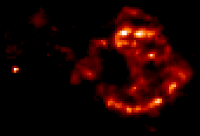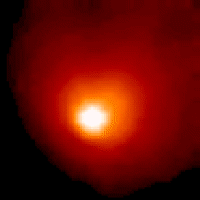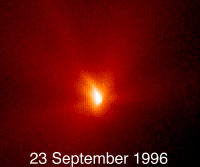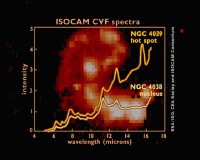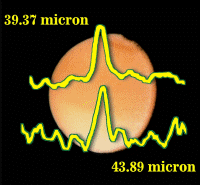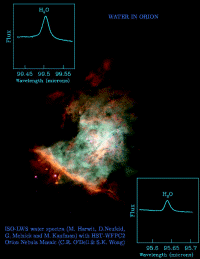Water throughout the universe!
Planet formation around a dying star
Astronomers at the universities of Amsterdam, Louvain, Groningen and Utrecht have found proof that planets can form around old, dying stars. In the vicinity of the Red Rectangle, an old binary star in the Monoceros constellation, they have detected a ring of matter constituting the first stage of planet formation. Their results were published in Nature on 26 February 1998. It had previously been assumed that planets can form only round new-born stars.
Useful links
Fluoride molecules in interstellar space
A team of astronomers from the United States and Germany discovered trace amounts of hydrogen fluoride gas in the near vacuum of interstellar space.
Although approximately one hundred different kinds of molecules have been detected in interstellar space over the past 30 years, the discovery of hydrogen fluoride marks the first time that a molecule containing fluorine has been detected in an interstellar gas cloud. The discovery was reported in the Astrophysical Journal Letters.
The astronomers searched for hydrogen fluoride molecules within a giant cloud of interstellar gas located near the centre of the Milky Way galaxy. The new observations were carried out with the Long Wavelength Spectrometer, one of four instruments on board ISO. Looking in the far-infrared region of the electromagnetic spectrum, the astronomers observed the telltale signature of absorption by trace amounts of hydrogen fluoride gas.
Useful links
LWS spectrum of fluoride molecules at the ISO Science Results Gallery
Studying a supernova
The remnant of a supernova remains discernible for thousands of years after the explosion. The most recent supernova observed in the Milky Way Galaxy occurred little more than 300 years ago and the resulting nebulous object is called Cassiopeia A. ISO has made the first detailed examination of Cassiopeia A by infrared rays unobservable from the Earth's surface. It gives direct evidence of dust formation.
Figure 3. ISOCAM image of the supernova remnant Cassiopeia A
Useful links
Dust grains in the debris of an exploded star at the ISO Science Results Gallery
The cosmic egg from which a star will hatch
One prize sought by ISO astronomers has been the detection of the earliest stages of star formation. Pre-stellar cores are egg-like objects hidden within a larger dust cloud. A cold, thick shell of dust obscures the interior, where gas collapses under gravity to make an embryonic star. By the time the dust has dispersed, and the object inside has hatched as a plainly visible star, the main event of star formation is complete. In the earliest stages, only radio waves and far-infrared rays can escape from the dust cloud, allowing us to observe the real origins of the stars.
Derek Ward-Thompson of the Royal Observatory Edinburgh (UK) and his colleagues at Cambridge University and in France, first detected the pre-stellar core L1689B, using observations at sub-millimetre radio wavelengths, in the constellation Ophiuchus. It is a very young pre-stellar core, on the brink of collapsing to form a new star. Now the team has used ISO to make the first infrared images of L1689B using the photometer ISOPHOT at long infrared wavelengths, up to its limit of 240 microns. The shell of dust is so cold, at roughly minus 260 degrees Centigrade (or 13°K), it is undetectable even at short or medium infrared wavelengths.
Astronomers can now combine ISO's results with observations of the same object and others like it, at sub-millimetre radio wavelengths, to build up a detailed picture of the earliest stages of star formation.
Useful links
ISOPHOT image of a pre-stellar core at the ISO Science Results Gallery
Dust amid the galaxies
ESA's Infrared Space Observatory ISO has detected dust for the first time in the apparently empty space between the galaxies. German and Finnish astronomers made the discovery in the northern constellation of Coma Berenices, where more than 500 galaxies swarm together in the Coma Cluster. The intergalactic dust is concentrated towards the centre of the cluster.
In the past, astronomers have considered intergalactic space to be extremely clean. Except in the vast concentrations of stars, gas and dust that make up the galaxies themselves, the Universe was supposed to be filled only by very thin traces of invisible gas. ISO's detection of dust means that the Universe is less transparent than astronomers have assumed. Their cosmic window-pane is slightly dirty and large-scale inferences based on the brightnesses of distant galaxies and quasars may be affected.
Useful links
Intergalactic dust in the coma cluster at the ISO Science Results Gallery
ISO's analysis of comet Hale-Bopp
The discovery of Comet Hale-Bopp occurred before ISO's launch in November 1995. When first observed by ISO in March and April 1996, the comet was still 700 million kilometres from the Sun, and almost as far from the Earth and ISO. With its privileged view of infrared wavebands inaccessible from the Earth's surface, ISO's spectrometer in ISOPHOT discovered that carbon dioxide was an important constituent of the comet's emissions of vapour. ISOPHOT measured the temperature of the dust cloud around Comet Hale-Bopp. In March 1996, when the comet was still more than 700 million kilometres from the Sun, the dust cloud was at -120°C. When ISOPHOT made similar observations in October 1996, the comet was 420 million kilometres from the Sun, and the dust cloud had warmed to about -50°C.
Figure 4. Comet Hale-Bopp by infrared light (ISOCAM infrared image at 15 microns, 1 October 1996. Credits: P. Lamy and the Hale-Bopp team, image processed by R. Walsh at ESA Villafranca)
Figure 5. Hubble view of comet Hale-Bopp by visible light, 23 September 1996 (Field is 21 km wide. Credits: HST, H. Weaver and WFPC2 team)
Useful links
Comet Hale-Bopp at the the ISO Science Results Gallery
ESA Press Release: ISO's analysis of comet Hale-Bopp
ISO reveals the energy source of luminous galaxies
Observations with ISO have revealed that the most famous of the enigmatic ultraluminous infrared galaxies (Arp220) is powered by an outburst of star formation, not by a central black hole. The same is true for all but one similar galaxies observed so far. Ultraluminous infrared galaxies (ULIRGs), the most luminous objects in the local universe, were detected in the 1980s by their prodigious emission of infrared radiation, but the origin of their enormous luminosities has yet remained unclear. The hopes of many astronomers were hence put on ISO, which allowed to study in unprecedented detail the infrared radiation, having wavelengths longer than visible light.
Useful links
Two galaxies colliding
Collisions between galaxies, each containing billions of stars, are the biggest events since the origin of the Universe. They may occur often enough to play a major role in the evolution of galaxies, and they provide a major theme for ISO's research teams. Collisions trigger star formation within dense dust clouds. These are opaque to visible light, so that even the Hubble Space Telescope is blind to the events within them.
Figure 5. ISOCAM CVF spectra of the Antennae galaxies, NGC 4038 and NGC 4039
One target for ISOCAM was a pair of galaxies known as the Antennae, 60 million light-years away. The name comes from antenna-like streamers of stars torn from the galaxies by a collision. The galaxies look quite similar by visible light. With its ability to harvest and analyse infrared rays, ISO distinguishes between the different kinds of commotion provoked by the encounter.
Useful links
A galactic refrigerator
The Long-Wavelength Spectrometer covered a range of the infrared spectrum entirely blotted out by the Earth's atmosphere. Instruments in high-flying aircraft and balloons have glimpsed some features in the sky at long infrared wavelengths, but only ISO offered a clear view. As a result the Long-Wavelength Spectrometer has been able to observe, in a wide variety of cosmic settings, radiation that plays an important part in cooling the Milky Way Galaxy.
Emission at a wavelength of 158 microns (about a sixth of millimetre) come from ionized carbon atoms in the clouds that fill the spaces between stars. The Long-Wavelength Spectrometer has picked up the emissions from a region where stars are being born, from a dying star, from warm and cool clouds of dust and gas, and even from extremely cold clouds of hydrocarbons called infrared cirrus. Although completely invisible to the eye, the energy shed in this way may be equivalent to the light of a billion stars. It affects the energy budget - and therefore the temperature - of the Milky Way, and of other galaxies too.
Useful links
Interstellar cirrus at the ISO Science Results Gallery
Last updated: 29 March 2000
Water throughout the universe!
Many of ISO's discoveries haven't come out yet because they are still being processed by researchers. These are some of the results published so far.
Because of the Earth's atmosphere acting as an opaque screen, only with ISO have astronomers been able to study the chemistry of the Universe in detail. One of the most mind-boggling discoveries they've made is that there's a lot of water vapor in the universe.
Indeed, ISO's found the telltale signature of water in starforming regions; in the vicinity of stars at the end of their lives; in sources very close to the galactic centre; in the atmospheres of planets in the Solar System. On the whole, scientists estimate the total amount of water in our own galaxy to be millions of times the mass of the Sun.
In the giant planets' atmospheres
There is gaseous water, for instance, in the upper atmospheres of the giant planets. On average, Jupiter, Saturn and Uranus are showered by 10 kilograms of water per second. The problem is that scientists do not know where this water vapour comes from. It is not very likely that the water vapour comes from deeper in the planetary atmosphere. This is because water vapour from sources such as evaporating oceans would freeze into clouds when it reached the cold outer atmosphere, a very common process here on Earth. An outside source - such as tiny frozen comet nuclei pummelling the atmosphere - is therefore a much more likely explanation.
On Titan
The detection of water vapour on Titan's atmosphere -Saturn's biggest moon, where the NASA-ESA mission Cassini-Huygens is now headed- will surely help to solve the problem mentioned above. Scientists will now be able to better understand the chemical processes taking place in this cold moon, maybe only just too cold to bear life.
Figure 1. Water vapour on Titan (Spectra: ESA/ISO/SWS and Coustenis/Salama et al. Photo of Titan: JPL, Voyager 2, 23 August 1981
In the Orion Nebula
Astronomers using ISO have also found water vapor in the Orion Nebula. Actually, they've detected by far a larger amount of water than that previously measured in other interstellar clouds. Scientists knew water vapour was present in clouds close to starforming regions -like the Orion Nebula- but they have no explanation yet as to why there should be such an enormous concentration of water vapour there. They say the "huge chemical factory" observed in Orion generates "enough water molecules in a single day to fill the Earths's oceans sixty times over."
Figure 2. Hubble image of the Orion nebula with spectra from ISO's LWS (Long Wavelength Spectrometer).
This discovery may have also implications for the origin of water in the Solar System and on the Earth itself, and models explaining the evolution of molecular clouds where stars are born will surely have to be revised.
Useful links
For more information and images, please consult:
ISO finds a steamy cloud in interstellar space (10 April 1998)
New water and remote galaxies complete ISO's observations (07 April 1998)
Europe's space telescope ISO finds water in distant places (12 June 1996)
Cosmic water traced by Europe's space telescope ISO (12 June 1996)

